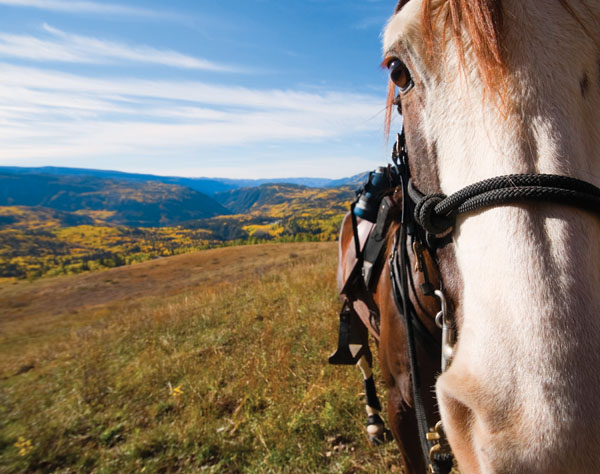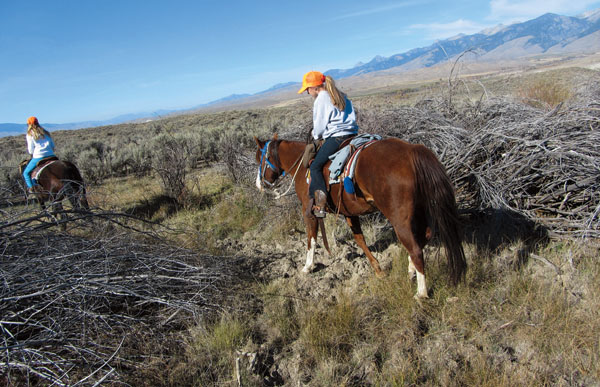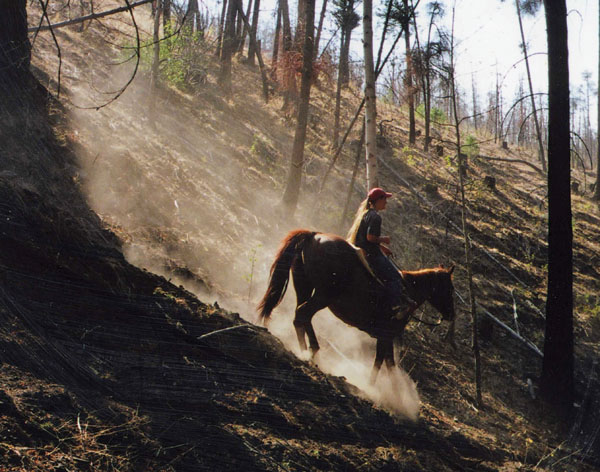Taking your trail ride off the beaten path nets unique experiences, unseen views, and peaceful tranquility, but not without risk. The “road less traveled” can present unexpected, challenging, and even dangerous situations for you and your horse.
[RELATED: Be Aware on the Trail for Safety]

Minimizing risk requires the ability to recognize these potentially dicey situations before you get yourself and your horse into trouble. Here I’ll cover eight of the most common hazards you might encounter on a less-traveled trail, how to recognize them, and steps to safely navigate them.
Keep in mind that each geographic region and climate has its own unique terrain, rock and soil formations, vegetation, and other bugaboos. Research the specific nature of the area in which you generally ride to become familiar with the possible hazards to avoid. When exploring a new area, find out as much as possible about it and/or try to ride with someone with experience in that terrain—especially if you’re going for an extended trek through the backcountry.
Backcountry Bugaboo: Old/Downed Wire
Why beware: Wire comes in many forms, such as an old, downed fence around a homestead site or farm that was abandoned years ago and went back to nature. Or you could stumble onto wires or cables used in logging operations. You might find abandoned power, phone, or telegraph lines hidden by brush and grass. Old barbed wire is one of the most dangerous hidden hazards, especially if it’s hidden in tall grass or overgrown brush.
A loose strand of wire is less likely to cause injury, unless your horse gets a tangle of it around his foot or leg, can’t get free, and the wire spooks him into leaping and bucking. Wire is especially dangerous if it’s still hooked to old posts or so deeply buried in vegetation that it’s well anchored. If your horse gets tangled (or hits the wire and it catches on his foot), spooks, and tries to take off or rush backward, the anchored wire won’t come loose and can saw deeply into his leg.
Ancient power lines or other service lines that have long since fallen down can be intact and running along the ground for miles, often covered with vegetation except for where they cross a gully. Or they may’ve been broken and dragged around by wildlife and livestock travel, ending up in tangles and snarls several hundred feet from their original locations.
Preparation pointer: When riding in groups, anyone who sees wire or hears his/her horse hit a piece of wire should immediately warn the others where it is and be on the lookout for more.
For optimal safety, familiarize yourself with the area’s history. Were there old homesteads or abandoned farms on your path? Were there old mines, mill sites, or ghost towns that had power lines going miles cross-country to their location? If you have an idea of what might be there, you can be more alert to signs of earlier human activity, and watch more closely for what your horse might stumble into.
If, despite your research and eagle eye, your horse gets entangled in wire, the time you spent ground training him will pay off. If he’s accustomed to the sensation of something touching his legs, or the sound of his shod foot hitting a tangle of wire, he’ll stop and stand still—and trust you. This’ll give you a chance to bail off and carefully extricate his feet or legs from the wire, rather than having him explode in terror. Take a multi-purpose pocketknife on every ride, in case you need to cut a wire to extricate your horse.
Backcountry Bugaboo: Rodent Holes
Why beware: You’re loping across an open meadow when it happens—your horse steps into a rodent hole. He could break his leg (and your neck, as a result of the tumble you take off his back). Even at a walk, an errant step into a hole can cause a tendon injury (and the abrupt disruption of his stride could wrench your back).

Badgers, prairie dogs, and ground squirrels are some of the critters that create underground dens. You’ll notice a badger hole thanks to the mound of dirt next to it if it’s on open ground with very little vegetation around it. But tall grass or vegetation can obstruct your view in many cases.
Preparation pointer: Prairie dogs and ground squirrels live in colonies and usually give advance notice to their presence. You often see or hear some of them standing by their holes and scolding you before you get there. An active colony is easy to see, thanks to freshly dug holes and sentinels on lookout. An abandoned colony can be trickier, especially if grass has grown up around the old holes and they are obscured from view until you blunder into them.
Backcountry Bugaboo: Wasp and Hornet Nests
Why beware: These buzzers can attack as individuals or as a horde. Worst-case scenario is if you or your horse accidentally bump a nest and the disturbed wasps or hornets attack as a horde. On occasion they’ll attack even if you are not very close. Wild bees and hornets sometimes seem angered and attracted to movement or to the smell of horses’ sweat, and seek you out. Your only defense in this instance is to get as far away from their nest as you can, as fast as you can, especially if they’re stinging you and your horse. Be careful, however, to watch your route and footing. You don’t want to flee one danger and blunder into another, risking injury while hurrying through dense thickets or risking a fall while scrambling along steep or hazardous terrain.
Ground-dwelling yellow jackets are especially aggressive if your horse happens to step in their nest hole. They can sting as viscously and repeatedly as a hornet or wasp. Sometimes you have a chance to see them first, if you are paying attention to the trail or footing; there’ll be a small depression or hole in the ground, and you’ll notice one or more of the black and yellow insects flying in or out of it.
Preparation pointer: These can sometimes be so hidden you don’t see them until the last minute, or not see them at all, especially if it’s a group of ground-nesting yellow jackets. Hornets’ paper nests (hanging in trees or bushes) are easiest to see, but can be somewhat obscured by branches or leaves. Sometimes the only clue is when you notice some of them buzzing around. This may or may not mean you are close to a nest, but it pays to start looking. If you see a nest, skirt around it and avoid going close to it.
Backcountry Bugaboo: Burn Areas
Why beware: The past two decades have left a lot of the backcountry scorched by wildfires caused by heavy fuel loads (from curtailment of logging and grazing in many regions and buildup of old, dead material), dry summers, prolonged drought, and lightning. There are a number of hazards when riding through recent burns, and some of those cause problems for many years.

Huge thickets of dead, standing trees are often part of a fire’s aftermath. You might not be able to avoid traveling through them, so keep in mind that any dead tree is no longer limber. The branches can be totally gone, but a flash fire can kill a tree and leave some branches intact. Be wary of sharp, stiff branches that can no longer bend out of the way. They could injure you or your horse if you brush against them, causing scrapes, punctures, or loss of an eye. A stand of beetle-killed trees will be just as dry and injurious—maybe more so than fire-killed trees, because more of the old, stiff branches are intact.
Hidden holes left by fires that burn so hot that they consume whole trees—even their roots—smolder underground for days after the above-ground fire has died. This can leave hollowed-out places that are not always visible that can be hazardous even years later. Your horse will stumble and scramble through hidden holes, as the fragile ground breaks away.
Preparation pointer: Always avoid dead standing trees during a windstorm. Those trees no longer have living roots and readily break off and blow down. If you have a choice, skirt around the burned area. If you have to go through it, do so with care, and pick your way through slowly. Avoid going near old burned stumps or ash-laden depressions where a tree might’ve once stood; there can be hollowed areas radiating out from it where the roots were burned.
Backcountry Bugaboo: Hazardous Stream Crossings
Why beware: A large river is usually more dangerous than a small stream, just because of the volume of water and the possibility it might be deeper or swifter than you think. Hidden hazards include deep holes, swift currents, treacherous banks, mossy rocks with slippery footing, etc. A well-marked crossing—with evidence of livestock or wildlife travel—is usually safest. If other creatures or riders have crossed there, you can have more confidence. Sometimes you don’t have this option, however, and must take your chances on selecting a good spot.
Rapidly flowing water spread over a wide area could indicate a shallower depth, and still water could signify a deep pool, but not always. Study the stream/river carefully, and try to read the signs. High water during spring/early summer can be more treacherous than lower water in late summer or fall. High water masks dangers like undercut banks, hidden holes, and snags as well as present the risk of greater depth and force.
Preparation pointer: When crossing any stream that’s more than belly deep, remove tie-downs, martingales, or other gear that could hinder your horse’s complete freedom of his head and neck in case he stumbles into a deep hole, scrambles on slippery footing and goes down, or hits a deeper current and has to swim.
Also keep in mind that a swift current can disorient your horse as well as yourself. Always try to choose a crossing where there’s some leeway—plenty of “safe” water downstream and a good exit on the opposite bank. You can end up several feet or yards downstream when you finally exit, since your horse tends to move with the current rather than travel straight across. Try to point him a little upstream as you go into the water, and keep your eyes on a spot across the stream to help guide you.
Backcountry Bugaboo: Poor Footing
Why beware: Pick your route carefully, and assess the pros and cons of how you might negotiate a certain way to get from A to B. Should you angle directly down off the ridge and into the creek canyon, or take a longer way around if the most direct route takes you through slide rock shale or a steep sidehill with questionable footing? Sometimes it’s safer and easier to go a mile or so out of your way to avoid risky terrain.
Even if there’s a game trail through slide rock, it’s often not a very good route for your horse. He can scrape or injure his feet on the large, sharp rocks, or get a hoof caught between rocks. A fall on slide-rock can be serious for both you and your horse. If there is any other possible route, it’s usually worth avoiding the shale.
If your horse is accustomed to mountain country, he can probably negotiate a steep hillside. But some types of footing provide very little traction, causing your horse to scramble, even if he’s a trail veteran. Fighting for his balance on a steep slope can be scary—and dangerous if he tumbles down the mountainside.
Avoid steep slopes that are muddy after a rain, as well as grassy slopes, which can be slick unless your horse is shod with toe and heel calks. If you suddenly find yourself in a bad spot, don’t get off and lead your horse unless he’s utterly panicked and likely to tumble. An experienced, well-trained horse should keep his cool.
A hillside with very little vegetation covered in loose dirt or fine pea-gravel moves under your horse and provides very little traction; he’ll slide several inches or more downhill at each step. Assess the hillside carefully before you start down it or around it, so you won’t get caught in a treacherous situation. There may be a better, safer route.
[RELATED: Handing Trail Riding Emergencies]
Preparation pointer: Even if you’re afraid he’ll slip and fall, your horse can stand on slippery slopes better than you can. If you fall down or slide down the hill ahead of him, you could pull him off balance or he could slide right into you. Stay calm and ride it out as best you can. If you find it too risky to keep going around the hillside, head straight down. A horse can generally stay upright and keep his footing even if he has to slide down on his haunches. If his feet go out from under him going around the hill, however, he’ll likely go clear down, pinning your leg underneath him, or tumble down the mountain.
Backcountry Bugaboo: Deep Bogs; Bottomless Bentonite
Why beware: Swamps and deep bogs don’t always give obvious clues if they’re safe to cross or if you should take the time to go the long way around.

In regions with a lot of bentonite (old volcanic ash that was put down in deep layers thousands of years ago) or clay, keep in mind that some of these deep deposits can be bottomless when wet, making them especially treacherous in the spring or after a long period of rain. Most of these spots are easy to recognize because there’s no vegetation. When dry, these areas are an expanse (large or small) of crumbly material, or present a cracked, dried-mud surface. When wet, they have a slippery, clay-like surface. If saturated, this “mud” won’t hold up a large animal and your horse will sink to his belly. Always avoid these areas when wet.
The tricky part is when you think it’s dry, but it’s still wet underneath. If your horse breaks through the dry surface, he can sink. Unless there’s a good trail across it already, it pays to avoid these bare spots, and go around them.
Preparation pointer: Look closely for signs of animal crossings and trails; wildlife and cattle will generally cross it in the best places, where there’s some footing underneath and your horse won’t sink too deeply. If the material is completely dry, it’s usually safe to ride across it, especially if there’s an established animal trail.
Backcountry Bugaboo: Down Timber
Why beware: Deadfall can be hazardous to ride through, especially if the downed trees are thick. Even an established trail can have new windblown trees across it, and it’s not always possible to ride around them if you find yourself hemmed in by other trees, thick brush, a fence, or more deadfall.
Putting his leg down between two tightly-spaced logs results in pulled muscles, tendons, or ligaments when your horse tries to pull free. If he catches the leg, he could suffer a serious—even life-threatening—laceration if he bleeds severely or severs a tendon while trying to pull his foot out. If he panics and lunges because he feels hemmed in, or struggles to extricate himself from a bad situation, he could suffer serious injury or puncture himself on a sharp, dead branch or shattered, broken-off tree stump.
Preparation pointer: Pick your way carefully. Don’t get trapped in a situation where your horse is too unable to get over or under the next obstacle. Watch for sharp snags that can injure you or your horse or catch on your tack.
To prevent catastrophe, train your trail horse ahead of time to cross logs calmly, and then avoid any serious downfall where you might get into trouble. Even if you have to go several miles out of your way, it pays to go around a bad place if it means avoiding injury to your horse or you.






